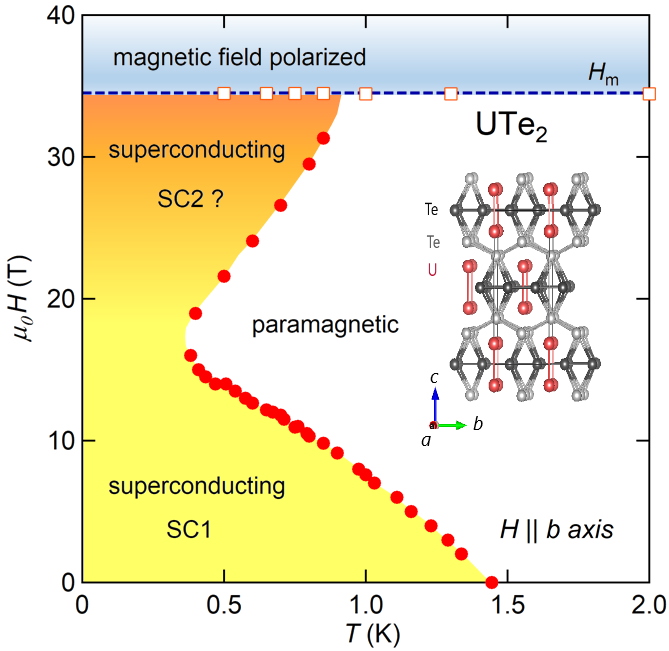UTe
2 is a paramagnetic metal with an orthorhombic crystal structure. It was recently discovered to be superconducting below 1.6 K (see
[1, 2]). The upper critical field
Hc2 above which superconductivity disappears is very anisotropic. The values of
Hc2 at zero temperature along the a and c axes of the crystal are 6 and 11 T, respectively. These are already far above the upper limit that is expected for a conventional superconductor. This observation is a first hint that UTe
2is, in difference to most superconductors, a spin-triplet superconductor. Such a superconductor is characterized by a pairing-state of two electrons with the same spin direction. This superconducting state is extremely rare in nature, but long sought for because of its possible topological properties.

Upper critical field of UTe2 for a magnetic field applied along the b axis. Above 16 T, superconductivity is reinforced by the magnetic field. Superconductivity disappears abruptly at 35 T, where a metamagnetic transition happens. It leads, due to a large jump of the magnetization, to a field polarized state. The insert shows the crystal structure of UTe2.
Even more spectacular is the superconducting phase diagram of UTe
2 for a magnetic field applied along the b axis (see figure), for which the magnetization is initially lowest at low temperatures
[3]. For temperatures below 0.4 K, UTe
2is superconducting up to a field
Hm ≈ 35 T; at this field the magnetization shows a large jump, hallmark of a metamagnetic transition. For slightly higher temperatures, superconductivity is first suppressed as the field increases, but astonishingly, superconductivity reappears at higher fields and survives up to the metamagnetic transition. Hence, the magnetic fluctuations associated to the metamagnetic transition seem to reinforce the superconducting pairing. By contrast, the long-ranged field-polarized phase above
Hm suppresses superconductivity.
The marked upturn of the upper critical field
Hc2 visible in the figure, also suggests that the superconducting order parameter might change above 16 T. Indeed, several models predict a change of the symmetry of the order parameter as the magnetic field increases. In experiments, however, no clear phase transition between two different superconducting states is observed so far.
The very marked upturn of the upper critical field
Hc2, visible on the left panel of the figure, also suggests that the superconducting order parameter could change with the application of a magnetic field above 15 T. Indeed, several theoretical models predict a change of the symmetry of the order parameter as a function of the magnetic field. In experiments however, no clear phase transition between two different superconducting states SC1 and SC2 has yet been observed, and this point remain an open question for future studies.
While the reinforcement of superconductivity occurs in the vicinity of the b axis in UTe
2researchers in the US discovered another superconducting phase of UTe
2 at even higher fields [
Hm taken from S. Ran
et al.
Nat. Phys. 15, 1250 (2019)], when the field is turned about 30 degrees from the
b to the
c axis. Using the long pulse-field magnets of the LNCMI in Toulouse, we also found that this high-field superconducting state exists only in the field-polarized phase above 45 T, and up to 60 T at least (the highest field we could measure
[4]). This reentrance of superconductivity above the metamagnetic transition was completely unexpected: it urges for further experimental studies, as well as it provides an exciting challenge for theory.
Contact:
Georg Knebel